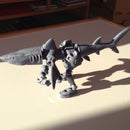Introduction: Making a Customizable Key Tag Using 123D Design Online
I recently had to design a set of objects to distribute at a technology event, made to be easily 3D printable and customizable, ideally by people who are not very familiar with 3D design software.
One useful small item is a customizable key tag, big enough that you don't lose or forget important keys.
Given my background with consumer 3D printing, I set out to design an object that would print really fast, and would look nice.
If you want to save time and see the final result: Edit the keychain in 123D Design Online
You can also use the gallery link: http://www.123dapp.com/smb-123D_Design/Keychain/1264529
Step 1: Using 123D Design Online
- It is easy to use - designed from scratch to do simple operations well
- It maintains an object "history", so any feature can be edited later - this allows for customization
- It runs in a browser - no need to install software or keep it updated
- Go to http://www.123dapp.com/
- In the Apps menu, select 123D Design
- If this is the first time you've used 123D Design, you'll be prompted to install a plugin
- You should also create an Autodesk account, or sign on with any of several social networks
Step 2: Adding Geometry and Joining Parts
Adding some basic shapes to scene is easy - drag and drop from the parts bin on the right of the screen.
In this case, add a cylinder, make it 20mm wide and long, and 5mm high. Also add a cube, 20x20x4mm.
You should be able to drag them together, and side of the square will snap to the middle of the cylinder.
Step 3: Joining Parts
In order to make it easier to work with, we're going to join those two parts into one. Select both parts, and in the toolbar at the bottom of the screen there will be an icon for joining parts (you can tell which one by hovering it over with the mouse pointer.)
Join the parts, and accept the warning dialogue.
Step 4: Making Holes
If we want to make a hole, we first need to make an object in the shape of the hole, define it as a void, and then "subtract" it from another piece. So let's select both parts, and then select the join part option. (Note that the LAST selected part will have the option to make it a void - apparently this will be fixed soon so that you have the option of making any part a void).
Now select the part that you want to use as a "tool" to make the hole, and you should see a slider for solid vs. void. Select void, and you have your hole.
Step 5: Making Rounded Edges
One of the most exciting features of 123D Design is the ability to make an edge a smooth rounded edge (fillet) or a bevel (chamfer). It makes your designs look really sleek and professional.
To do this, select the fillet tool in the toolbar, then select an edge. In this case we've selected the top edge of the cylinder. Then you can either drag a handle to increase the radius of the fillet, or type in a value directly. (You'll find this to be one of the most satisfying things you can do in this program!)
Step 6: Making the Tag Body and Hollowing It Out
Now it's time to make the body of the key tag.
Add another cube, make its dimensions 20x8x4mm. Pretty easy. Drag it next to the rounded tag end, and it should snap together.
We'd like to make a recess in the tag, to make it look prettier and make a frame around the text. This is very easy to do in 123D Design, there is a tool called "hollow", it's the hollow cube-like icon on the top toolbar.
Select it first and then select the top face of the tag body. You can either move a handle to define the width of the shell, or type in a value directly.
If you want to make the recess deeper, you can later use the Push-Pull tool in the toolbar to press down the bottom of the hollow.
Step 7: Adding and Editing Text
Text can be added from the parts bin or from the toolbar. You can edit the text at any time. Drag the text, and it should snap to a flat face on your object. Note that when you first select the text, the highlight will be yellow, and it looks like the text is not editable. Click again, and the highlight will turn blue. (The yellow indicates that you are selecting a part, and the blue indicates that you are working with a feature of a part).
A nice feature of 123D Design Online is that text remains editable even when you're done editing the part, so it makes it easy to publish customizable objects (like this one!).
Step 8: Export a Printable File
Make sure to save your project to your online storage (My Projects). Now, go to 123dapp.com, and find the menu with your name (top right). Go to the option for "my models and projects". If you only see an option for Save/Download, it means your 3D print ready file is not ready yet.
Enjoy a coffee, or a snack!
Reload the page in your browser, and under the "Save/Download" options you should see an STL file. Download this, and print it according to the instructions for your 3D printer.
Alternatively, you can use the Fabricate menu to get your piece printed using one of the 123D 3D printing partners.













